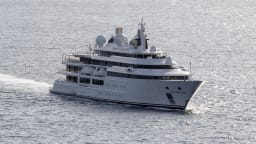The carrying costs of maintaining a yacht worth $50 million or more are prohibitive.
One way to reduce the impact on the government which seized it is to sell the asset and put the funds received in escrow until related court cases are resolved. And the one thing an oligarch likes more than a big yacht is liquid assets. JL
Scott Bixby reports in Daily Beast, image Francisco Ubilla, AP:
The economics of keeping a vessel worth $90 million afloat as the Justice Department pursues charges of bank fraud, money laundering, and sanctions violations —and the legal particulars of seizing ill-gotten gains by alleged criminals—means (they) could soon end up on the block in order to pay off the phenomenal carrying costs for vessels with room for 14 guests and 22 crewmembers. “If the maintenance and storage become prohibitively expensive, the government can go to the court and say, ‘we want to sell this and reduce it to cash.’" The money would be held in escrow until the resolution of (the) case.The Department of Justice made a splash with the announcement that the task force created to seize the assets of Russia’s richest citizens had captured its first major acquisition: Tango, the 255-foot megayacht owned by sanctioned oligarch Viktor Vekselberg.
But the economics of keeping a vessel worth an estimated $90 million afloat as the Justice Department pursues charges of bank fraud, money laundering, and sanctions violations against Vekselberg—and the legal particulars of seizing ill-gotten gains by alleged criminals—means that Tango could soon end up on the chopping block in order to pay off the phenomenal carrying costs for a vessel with room for 14 guests and 22 crewmembers.
“If the maintenance and storage become prohibitively expensive, the government can go to the court and say, ‘we want to sell this and reduce it to cash,’” said Stefan Cassella, a former federal prosecutor and an expert on asset forfeiture and money laundering law. Vekselberg “wouldn’t be able to object to the government selling it at auction for fair market value and turning it into a liquid asset. And that happens a lot.”
Last month, following Russia’s unprovoked invasion of neighboring Ukraine, President Joe Biden vowed in his State of the Union address to join European allies to find and seize the yachts, luxury apartments, and private jets of billionaire oligarchs close to the Kremlin.
“We are coming for your ill-begotten gains,” Biden said at the time.
The seizure of Tango is the first such capture of luxury assets by the Federal Bureau of Investigation, Andrew Adams, director of the Department of Justice’s Task Force KleptoCapture, said upon the yacht’s seizure. But is far from the last.
“Today’s seizure of Viktor Vekselberg’s yacht, the Tango, in Spain is the result of an unprecedented multinational effort to enforce U.S. sanctions targeting those elites who have enabled Russia’s unprovoked and illegal invasion of Ukraine,” Adams said at the time. “For those who have tied their fortunes to a brutal and lawless regime, today’s action is a message that those nations dedicated to the rule of law are equally dedicated to separating the oligarchs from their tainted luxuries. This seizure is only the beginning of the Task Force’s work in this global effort to punish those who have and continue to support tyranny for financial gain.”
Federal law enforcement officials with knowledge of the task force’s work, however, told The Daily Beast that the impressiveness of the haul is as much a complication as it is an accomplishment. The seizure of physical property suspected of being related to criminal enterprise—cars, homes, and jewels—is often a little more manageable than a 255-foot megayacht.
“A Bugatti can be kept under a tarp in a garage until a case is concluded,” one federal law enforcement official told The Daily Beast. “The same can’t be said of a yacht that’s the length of a football field.”
Tango, which according to Superyacht Times currently clocks in as the 189th-longest yacht in the world and features a private owner’s deck, a contra-flow swimming pool, an outdoor cinema and a massage parlor, is far from the most extravagant of the yachts that have been seized by international authorities since the implementation of sanctions against Kremlin-allied oligarchs following Russia’s invasion of Ukraine. Dilbar, the world’s largest yacht by gross tonnage, was seized earlier this month by Germany. It features two helipads and the largest swimming pool yet installed on a yacht.
But even the comparatively unpretentious Tango will cost a small fortune to keep afloat. In the yachting world, the rule of thumb for the annual carrying costs of a crewed vessel is roughly 10 percent of its sticker price, with that percentage rising depending on the yacht’s size, sophistication, and whether it is currently at sea.
Megayachts have dozens of crew members for a reason—not just to serve guests daiquiris and change their sheets, but also to keep the vessel from falling apart. Some of the risks include salt damage to the hull and furnishings, sea water entering the fuel tanks causing “diesel bug” bacterial growth in the engine, barnacles, sun exposure, and even excrement from seagulls. Each can destroy a yacht in slow motion, which means that these freshly seized assets could be worthless by the time their owners’ cases have been adjudicated.
The majority of the yachts seized so far have been nabbed by foreign law enforcement agencies, many of which seem content to allow them to fall fallow in the meantime. But in the United States, the U.S. Marshals Service is often in charge of taking custody of seized assets, and is required by law to maintain them—even as the yacht remains moored at the Real Club Nautico in Palma, Mallorca.
“If the government does take it into its possession, then it is responsible for the storage and maintenance costs until there’s an interlocutory sale,” Cassella said.
Although sometimes the work is farmed out to a private contractor, the costs are often covered by an asset forfeiture fund, built up from the proceeds of seized goods—things like watches and furs, rather than bricks of cash and machine guns—being sold for their commercial value.
In practice, this can be achieved by requiring the owner of the seized property to fund the maintenance of their car, boat, or plane—or by using the proceeds of forfeited goods sold at auction to keep them in working order.
But in the case of Task Force KleptoCapture’s targets, sanctioned individuals can’t pay their crews or mooring fees as they fight to win their yachts back due to the restricted access of their own fortunes. This effectively prevents Vekselberg, worth an estimated $10 billion before the implementation of sanctions, from paying an estimated $4 million a year to keep Tango seaworthy—even if he wanted to.
And given that Vekselberg is overseas and has enormous resources at his disposal, the case, Cassella said, could stretch on for years—with the U.S. Marshals on the hook in the meantime.
“This could go on for a very long time,” said Cassella. “Forfeiture cases of this complexity, with this amount of money, could go on for five or 10 years.”
According to the Luxury Yacht Group, that could mean the government’s total carrying costs for Tango could stretch into the tens of millions—potentially even exceeding the yacht’s value.
The U.S. Marshals Service does have the option of putting the boat on the auction block, like a cocaine dealer’s slightly used Dodge Viper at a police auction. The money would be held in escrow until the resolution of Vekselberg’s case.
But the international superyacht market has tanked along with the rest of the luxury goods economy—rising fuel prices hit harder when it takes 202,000 liters of premium diesel to fill your tank—which means that would-be megayacht owners could end up scoring a major deal.
And Vekselberg, one State Department official familiar with the sanctions efforts quipped, could learn a critical lesson in luxury good ownership.
“If it floats, flies or fucks,” they said, “rent—don’t buy.”























1 comments:
smm panel I always prefer to read high-quality stuff, which I discovered in your article. Thank you for providing this information. smm heart
Post a Comment